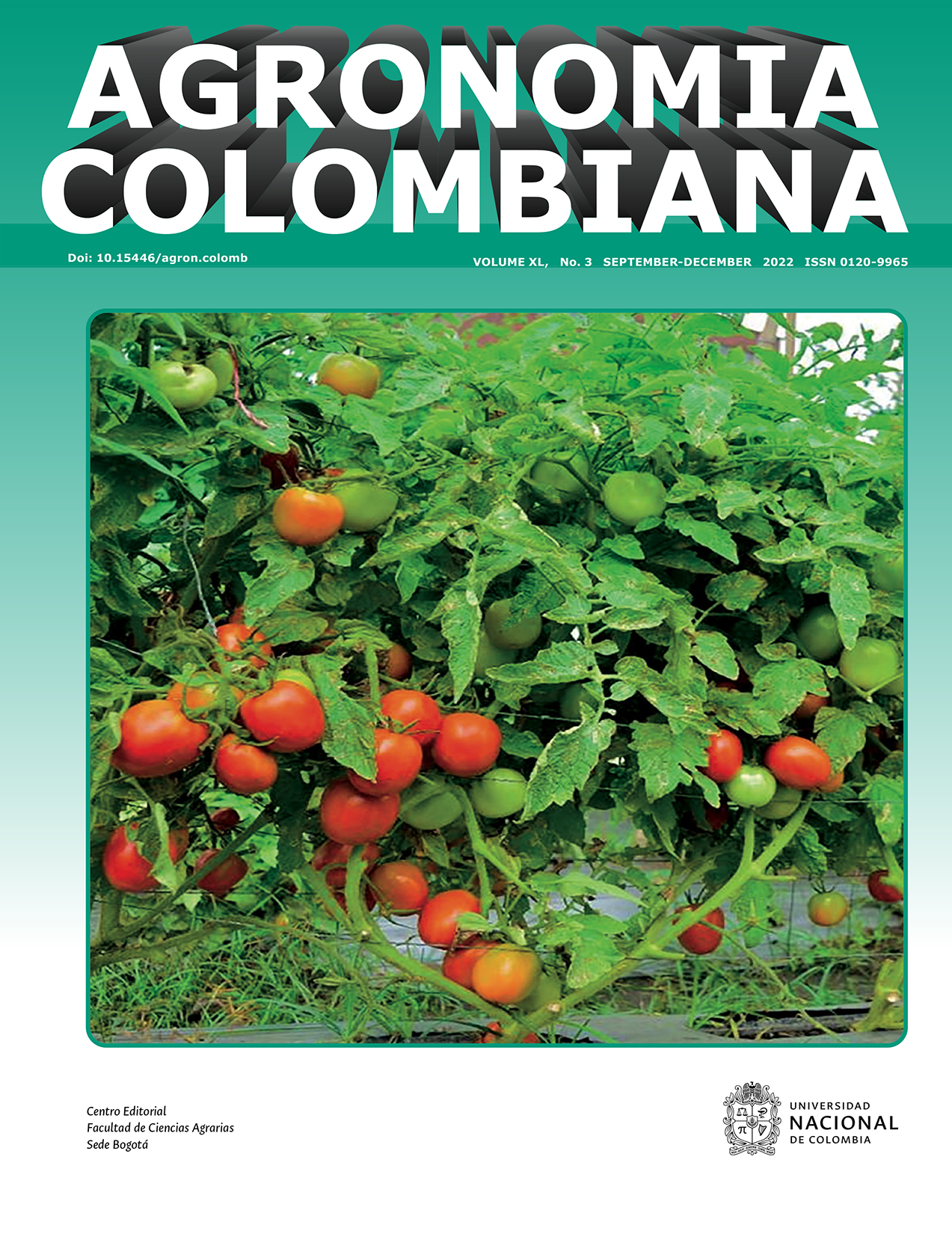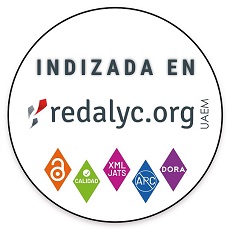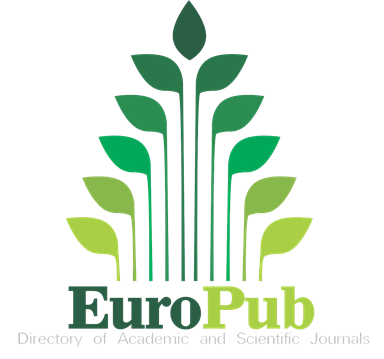Discriminant analysis for estimating meristematic differentiation point based on morphometric indicators in banana (Musa AAA)
Análisis discriminante para estimar el punto de diferenciación meristemática basado en indicadores morfométricos en banano (Musa AAA)
DOI:
https://doi.org/10.15446/agron.colomb.v40n3.103234Keywords:
allometry, pseudostem, phenological stages, non-destructive methods (en)alometría, seudotallo, etapas fenológicas, métodos no destructivos (es)
Downloads
In the banana crop, leaf area is a fundamental trait for production; however, monitoring this variable during a cycle is difficult due to the structural characteristics of the plant, and a method for its determination is necessary. Therefore, the objective of this research was to propose a model for estimating total leaf area by measuring the cross-sectional area of the pseudostem to identify when meristematic differentiation occurs. In plants between F10 and flowering, functional leaves were measured for length, width, and dry mass. Cross-sectional area was calculated every 10 cm from the base to 70 cm, at ⅓, ½ of the plant height and up to the last pair of leaves. From the principal components, the cross-sectional measurement at 50 cm was selected, obtaining a nonlinear model for indirect estimation of leaf area. Subsequently, Fisher’s linear discriminant analysis was used with the parameters associated with the number of leaves emitted and the estimated leaf area to obtain the cutoff point as the centroid of the extracted components. As an indicator for the approximate identification of the moment of meristem differentiation, the emission of leaf 12 was generated, which determines the phenological stage (vegetative-reproductive) of the plant. The results describe tools to follow up the growth in the productive units to facilitate crop monitoring, allowing the generation of differential production approaches.
En el cultivo de banano el área foliar es una característica fundamental para la producción; no obstante, el monitoreo de esta variable durante el ciclo se dificulta por las características estructurales de la planta, siendo necesario algún método para su determinación. Por lo tanto, el objetivo de esta investigación fue proponer un modelo de estimación del área foliar total, mediante la medición del área de la sección transversal del seudotallo, para identificar cuando ocurre la diferenciación meristemática. En plantas entre F10 y floración se midió en las hojas funcionales largo, ancho y masa seca. El área de la sección transversal se calculó a 10 cm de la base hasta 70 cm, a ⅓, ½ de la altura de la planta y hasta el último par de hojas. A partir de los componentes principales se seleccionó la medida de la sección transversal a 50 cm, obteniéndose un modelo no lineal de estimación indirecta del área foliar. Posteriormente se utilizó el análisis discriminante lineal de Fisher con los parámetros asociados al número de hojas emitidas y al área foliar estimada para obtener el punto de corte como centroide de los componentes extraídos. Se generó como indicador para la identificación aproximada del momento de la diferenciación del meristemo la emisión de la hoja 12, y con esto la determinación de la etapa fenológica (vegetativa-reproductiva) en la cual se encuentra la planta. Los resultados describen herramientas para hacer seguimiento al crecimiento en las unidades productivas que facilitarían el monitoreo del cultivo, permitiendo generar enfoques de producción diferenciales.
References
Belalcázar, S. (1991). El cultivo del plátano (Musa AAB Simmonds) en el trópico. Cali, ICA – CIID – CDCQ – INIBAP. Manual de Asistencia Técnica No. 50.
Borja Agamez, W., Osorio, J. D., Herrera, N., & Sánchez, J. D. (2018). Fundamentos en fenología de banano Cavendish (Musa AAA) en cultivo establecido. Boletín Técnico Cenibanano, 1, 1–4.
Briggs, W. (2016). Uncertainty. The soul of modeling, probability & statistics. Springer. https://link.springer.com/book/10.1007/978-3-319-39756-6 DOI: https://doi.org/10.1007/978-3-319-39756-6
Chang, S., Wu, Z., Sun, W., Qiao, L., Zeng, Q., Zhang, J., & Shu, H. (2018). A method to predict banana pseudostem’s strength at seedling stage. Advances in Bioscience and Biotechnology, 9(9), 391–396. https://doi.org/10.4236/abb.2018.99027 DOI: https://doi.org/10.4236/abb.2018.99027
Dépigny, S., Achard, R., Lescot, T., Djomessi, M. T., Tchotang, F., Ngando, D. E., & Poix, C. (2015). In vivo assessment of the active foliar area of banana plants (Musa spp.) using the OTO model. Scientia Horticulturae, 181, 129–136. https://doi.org/10.1016/j.scienta.2014.10.044 DOI: https://doi.org/10.1016/j.scienta.2014.10.044
Gower, J. C., & Hand, D. J. (1995). Biplots. Monographs on statistics & applied probability. Chapman & Hall.
Jorquera-Fontena, E., Génard, M., Ribera-Fonseca, A., & Franck, N. (2017). A simple allometric model for estimating blueberry fruit weight from diameter measurements. Scientia Horticulturae, 219, 131–134. https://doi.org/10.1016/j.scienta.2017.03.009 DOI: https://doi.org/10.1016/j.scienta.2017.03.009
Karaca, C., Büyüktaş, D., & Şehir, S. (2020). Determination of leaf area of some vegetable plants grown under greenhouse condition by non-destructive methods. Horticultural Studies, 38(1), 23–28. https://doi.org/10.16882/hortis.841745 DOI: https://doi.org/10.16882/hortis.841745
Kumar, N., Krishnamoorthy, V., Nalina, L., & Soorianathasundharam, K. (2002). Nuevo factor para estimar el área foliar total en banano. Infomusa, 11(2), 42–43.
Laskar, S. Y., Weldesemayat Sileshi, G., Jyoti Nath, A., & Kumar Das, A. (2020). Allometric models for above and below-ground biomass of wild Musa stands in tropical semi evergreen forests. Global Ecology and Conservation, 24, Article e01208. https://doi.org/10.1016/j.gecco.2020.e01208 DOI: https://doi.org/10.1016/j.gecco.2020.e01208
Lassoudiere, A., (2007). Le bananier et sa culture. Quae, Collection Savoir-faire.
Martin Prevel, P. (1974). Les methodes d’echantillonnage pour l’analyse foliaire du bananier: resultats d’une enquete internationale et propositions en vue d’une reference commune. Fruits. In A. Lopez, & J. Espinosa, (Eds.), Manual on the nutrition and fertilization of banana (pp. 583–588). Potash and Phosphate Institute of Canada.
Martínez, A. M., & Cayón, D. G. (2011). Dinámica del crecimiento y desarrollo del banano (Musa AAA Simmonds cvs. Gran Enano y Valery). Revista Facultad Nacional de Agronomía Medellín, 64(2), 6055–6064.
Martínez, C., Cayón, G., & Ligarreto, G. (2015). Physiological attributes of banana and plantain cultivars of the Colombian Musaceae collection. Agronomía Colombiana, 33(1), 29–35. https://doi.org/10.15446/agron.colomb.v33n1.45935 DOI: https://doi.org/10.15446/agron.colomb.v33n1.45935
Martínez-Acosta, A. M., Jorquera-Fontena, E., Hernández-Arredondo J. D., & Franck, N. (2018). Sección transversal del pseudotallo como estimador del área foliar total en banano (Musa AAA). Un estudio preliminar. XXXII Reunión Argentina de Fisiología Vegetal y XVI Congreso Latinoamericano de Fisiología Vegetal (pp. 116).
Meier, W. (2001). Growth stages of mono and dicotyledonous plants. BBCH Monograph. Federal Biological Research Centre for Agriculture and Forestry. https://doi.org/10.5073/20180906-074619
Nowembabazi, A., Taulya G., & Tinzaara, W. (2021). Allometric functions for apple banana leaf area and above ground biomass. African Journal of Agricultural Research, 17(9), 1229–1236. https://doi.org/10.5897/AJAR2021.15478 DOI: https://doi.org/10.5897/AJAR2021.15478
Nyombi, K., van Asten, P. J. A., Leffelaar, P. A., Corbeels, M., Kaizzi, C. K., & Giller, K. E. (2009). Allometric growth relationships of East Africa highland bananas (Musa AAA-EAHB) cv. Kisansa and Mbwazirume. Annals of Applied Biology, 155(3), 403–418. https://doi.org/10.1111/j.1744-7348.2009.00353.x DOI: https://doi.org/10.1111/j.1744-7348.2009.00353.x
Oliveira, V. S., Santos K. T. H., Ambrósio, T. J., Santos, J. S. H., Santana W. R., Malikouski, R. G., Nascimento A. L., Santos G. P., Schmildt O., & Schmildt, E. R. (2019). Mathematical modeling for leaf area estimation from papaya seedlings ‘Golden THB’. Journal of Agricultural Science, 11(5), 496–505. https://doi.org/10.5539/jas.v11n5p496 DOI: https://doi.org/10.5539/jas.v11n5p496
Parker, G. (2020). Tamm review: Leaf Area Index (LAI) is both a determinant and a consequence of important processes in vegetation canopies. Forest Ecology and Management, 477, Article 118496. https://doi.org/10.1016/j.foreco.2020.118496 DOI: https://doi.org/10.1016/j.foreco.2020.118496
Santos, M. P., Maia V. M., Oliveira F. S., Pegoraro, R. F., Santos S. R., & Aspiazú, I. (2018). Estimation of total leaf area and D leaf area of pineapple from biometric characteristics. Revista Brasileira de Fruticultura, 40(6), Article e-556. https://doi.org/10.1590/0100-29452018556 DOI: https://doi.org/10.1590/0100-29452018556
Souto, A. G. L., Cordeiro, M. H. M., Rosado, L. D. S., Santos., C. E. M., & Bruckner, C. H. (2017). Non-destructive estimation of leaf area in passion fruit (Passiflora edulis L.). Australian Journal of Crop Science, 11(12), 1534–1538. https://doi.org/10.21475/AJCS.17.11.12.PNE662 DOI: https://doi.org/10.21475/ajcs.17.11.12.pne662
Stevens, B., Diels, J., Brown, A., Bayo, S., Ndakidemi, P. A., & Swennen, R. (2020). Banana biomass estimation and yield forecasting from non-destructive measurement for two contrasting cultivars and water regimes. Agronomy, 10(9), Article 1435. https://doi.org/10.3390/agronomy10091435 DOI: https://doi.org/10.3390/agronomy10091435
Turner, D. W., Fortescue, J. A., & Thomas, D. S. (2007). Environmental physiology of the bananas (Musa spp.). Brazilian Journal of Plant Physiology, 19(4), 463–484. https://doi.org/10.1590/S1677-04202007000400013 DOI: https://doi.org/10.1590/S1677-04202007000400013
How to Cite
APA
ACM
ACS
ABNT
Chicago
Harvard
IEEE
MLA
Turabian
Vancouver
Download Citation
CrossRef Cited-by
1. Nelino Florida Rofner, Cesar Augusto Gozme Sulca, Alex Rengifo Rojas. (2023). Modelling of alluvial soil quality and production in permanent banana Harton plantations. Soil and Water Research, 18(3), p.192. https://doi.org/10.17221/22/2023-SWR.
Dimensions
PlumX
Article abstract page views
Downloads
License

This work is licensed under a Creative Commons Attribution-NonCommercial-ShareAlike 4.0 International License.
© Centro Editorial de la Facultad de Ciencias Agrarias, Universidad Nacional de Colombia
Reproduction and quotation of material appearing in the journal is authorized provided the following are explicitly indicated: journal name, author(s) name, year, volume, issue and pages of the source. The ideas and observations recorded by the authors are their own and do not necessarily represent the views and policies of the Universidad Nacional de Colombia. Mention of products or commercial firms in the journal does not constitute a recommendation or endorsement on the part of the Universidad Nacional de Colombia; furthermore, the use of such products should comply with the product label recommendations.
The Creative Commons license used by Agronomia Colombiana journal is: Attribution - NonCommercial - ShareAlike (by-nc-sa)

Agronomia Colombiana by Centro Editorial of Facultad de Ciencias Agrarias, Universidad Nacional de Colombia is licensed under a Creative Commons Reconocimiento-NoComercial-CompartirIgual 4.0 Internacional License.
Creado a partir de la obra en http://revistas.unal.edu.co/index.php/agrocol/.





















